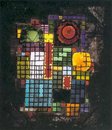Leadline 1994: Josef Albers: Works in Glass (Part One)
 by Jason Peter Brown on June 8, 2007
by Jason Peter Brown on June 8, 2007
 Filed Under: REPRINTINGS, LEADLINE
Filed Under: REPRINTINGS, LEADLINE
This article originally appeared in Leadline in 1994, and was one of the most popular on the old website. It was written by Doreen Balabanoff, and part one of a five part series has been reprinted below.
Josef Albers… the name has instant associations for most of us… the "Homage to a Square" series of abstract paintings which occupied the last 26 years of his life… a renowned pedagogy, developed at Black Mountain College and Yale University, and documented in the massive, 2-volume Interaction of Color, published in 1963…
But the main body of Albers' work remains little known to the public at large. Unless one has studied his work in isolation, or seen a major retrospective exhibition (most recently at the Guggenheim in 1988), there is little chance of having met the remarkable diversity of his creative endeavors. Stained glass, furniture design, graphic design, architectural art, printmaking, drawing and painting — Albers sought in all these media to explore the possibilities of 'material' and the ambiguities of human perception. His intellectual curiosity, rooted in a deep respect for craftsmanship, was always looking for "the discrepancy between the physical fact and the psychic effect" and for " new ways of seeing and using materials".
Amongst Albers' many lesser known works is a body of work done in the medium of glass — produced between 1920 and 1933, the years he spent at the Bauhaus. His tenure there, first as a student, and then as an increasingly pivotal faculty member, gave Albers the distinction of being the longest-standing Bauhaus associate. He became assistant director in 1928, and remained until its closure in 1933. Throughout this 13-year period, Albers tried his hand at many things, from typography to architectural design. But his primary medium was glass, and through it he developed his own unique mode of expression.
Rarely seen, many of them lost to war damage (all the architectural work) or damaged in transit to the U.S., Albers' works in glass have never had a comprehensive showing. This spring (1993), an exhibition of about thirty of his autonomous glass panels opened at the Peggy Guggenheim Collection in Venice, Italy. The exhibition is co-ordinated by the Albers Foundation in Orange, Connecticut and runs from March 30th to July 16th. It includes a selection of paintings as well, and is accompanied by a full catalogue, published by the Guggenheim. The show will travel in Europe (venues in Spain and Germany) before crossing the Atlantic to be shown in New York.
In terms of his lifelong body of work, Albers' glass works have much significance: through them he was led into abstract art, and developed many of the principles upon which his future work would be founded. In relation to the history of the medium of glass, Albers' architectural works are few but significant (and still all but unknown). And while his move to autonomous exhibition panels seems not unusual by contemporary standards, it was a remarkable exploration in the mid-1920's. Indeed, Albers' ability to shed the preconceptions which tend to dominate stained glass as a medium, to look with fresh eyes at glass as a material, is an ability not seen often enough in contemporary work in glass.
Before embarking upon the discussion of Albers' works in glass which follows, I would like to thank the Albers Foundation and its curators, Kelly Feeney and Brenda Danilowitz for their generous assistance and for providing the images to accompany my article. Their advice directed me to the unpublished doctoral dissertation of Irving J. Finkelstein, PhD., whose in-depth examination of Albers' oeuvre included an insightful and thorough discussion of the works in glass, and to whom I am indebted for many of the ideas presented here. Finkelstein did interview Albers on several occasions, and no doubt these conversations with the artist provided considerable material for his thoughtful analysis of this otherwise relatively undocumented work. Unless otherwise noted, all quotes are from his dissertation, completed in 1968.
Continued in Part Two.
